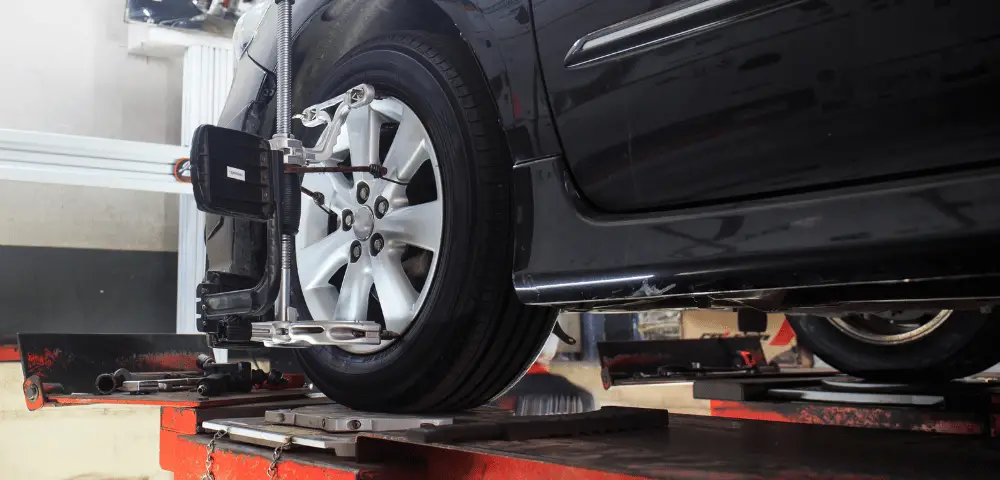Even if you manage to stop your car safely, you’ll be left wondering “why is it that my car pulls to the left and right while driving?”.
Oftentimes, this issue is caused by incorrect wheel alignment, damaged tires, or issues with the braking system.
Picture this: you’re cruising on a highway at average speed when your car suddenly starts to veer to either side.
Such a situation is not only unsettling but also risky. If you’re like most drivers, you may start to panic and take erratic measures like slamming hard on the brakes.
However, doing so only endangers your life more. Instead, you should remain calm so you can think clearly about the next steps to take.
The best measures to take entail slowing down, alerting other road users that you’re in distress, and pulling over.
Read on to learn why a vehicle starts pulling to one side.
What does it mean when your car moves side to side while driving?
If your car sways left and right when you drive, this is likely caused by one of the following issues.
Misaligned wheels
One of the most common causes of pulling is a car’s wheel alignment.
If this is the underlying problem, you’ll notice that the steering wheel pulls to either side while you drive or as soon as you let this steering wheel go.
If you identify this as the problem, you should get the wheels realigned as soon as possible to prevent uneven tread wear.
Thankfully, wheel alignment is pretty easy to fix using one of these three adjustment techniques:
- Camber adjustment – for starters, camber refers to the outward or inward inclination of the tire and wheel assembly, as seen from the vehicle’s front side. Therefore, the goal of camber adjustment is to ensure that none of the wheels are tilting too inward or outward.
- Caster adjustment – caster is defined as the rearward or forward tilt of the steering axis and suspension relative to the wheel. Thus, a caster adjustment helps to correct the positioning of the suspension relative to the wheel.
Specifically, it ensures that the suspension parts and steering axis form a 90-degree angle with the wheel.
Although you probably won’t spot this with your naked eye, it plays a crucial role in your vehicle’s alignment.
- Toe adjustment – toe is a measure of how far the front and/or back wheels are turned in or out as seen from the front.
The concept behind a toe adjustment is to ensure the front of the tire isn’t tipped.
This is achieved by either tightening or loosening the vehicle’s tie rod ends.
Although a tipped tire wouldn’t cause you to veer off, it can cause steering wheel misalignment which then leads to car pulling.
Faulty Wheel Bearings
Faulty wheel bearings are another reason why cars pull to the left and right.
The wheel bearing is the part that joins the wheel to the axle; enabling it to turn smoothly with minimal friction.
Thankfully, faulty bearings are easy to spot as your car usually portrays some warning signs.
For one, you’ll likely hear a grinding noise from the area around the tires.
Secondly, you’ll notice that the steering wheel shakes as you drive. Finally, the car will start to pull to the left and right.
If you notice any of these telltale signs, have a mechanic examine your car as soon as you can.
Tire Pressure Imbalance
If your wheels are perfectly aligned and the bearings are in pristine condition, then the most likely culprit for the car pull is uneven tire pressure.
Ideally, the air pressure on all four tires should correspond to the manufacturer’s recommendations. If this isn’t the case, this irregularity can cause the car to pull more to one side.
The easiest way to know whether the tires are under or over-inflated is to examine tire wear.
Overinflated tires wear out faster around the middle. Conversely, underinflated tires experience more wear around the outer edges.
If you notice any of these, use a tire pressure gauge to check the air pressure. If they’re under-inflated, consider adding more air and if they’re overinflated let some air out.
Why does my steering wheel keep yanking left and right?
A defective steering and/or suspension system can cause the steering wheel to yank left and right.
Here’s the thing, the steering and suspension systems are made up of several components, such as strut bearings, tie rods, and ball joints.
All of these suspension parts become worn over time, which increases their likelihood of failure. The end result of this is that your car starts to pull to one side.
The term given to this phenomenon is ‘memory steer’. Memory steer describes a situation where a car continues pulling in the same direction even after taking a turn.
To avoid this, have the steering and suspension components inspected annually. This way, you can repair any faulty elements before the situation gets worse and leads to a vehicle pull.
Why does my car still pull left after alignment?
If you notice that your car is still pulling to the left after alignment, there’s a high chance that the alignment wasn’t done properly.
Alternatively, it could be that the control arm bushings are faulty.
Control arm bushings are the parts that join the control arms to the frame of the car. They’re responsible for cushioning the suspension system; hence reducing overall vibrations and noise.
Why does my car pull in one direction when I brake?
Have you noticed your vehicle swerving only when you apply the brakes?
If you have, then you’re likely dealing with faulty brake calipers or a jammed brake pad. Here’s a more detailed breakdown of these issues:
Defective brake calipers
A braking system is made up of several parts, one of which is the caliper. The brake caliper is where the brake pads and pistons are located. Its function is to apply pressure so as to bring the car to a stop.
Brake calipers need regular maintenance to keep them working efficiently.
Without this, they can easily get jammed- an action that impedes the braking force. If they do get jammed, they’ll start to drag. The end result is that your car starts pulling to the left and right.
If you experience a pulling sensation every time you brake, take your car to a service center for immediate inspection. Driving a car that has brake problems is incredibly risky.
Wrecked brake pads
Whether your car has four or eight brake pads, you should inspect them regularly to ensure they’re not damaged.
When braking, the brake pads are the parts that come into contact with the rotors, generating enough friction to slow down the wheels’ rotation. If any of the brake pads is broken or made of flimsy materials, it can cause the vehicle to pull to one side.
To avoid this, invest in premium-quality brake pads.
Furthermore, inspect them on a regular basis so you can identify and replace any worn pads.
Conclusion

There are a number of things that cause cars to pull left and right when driving.
The most common reasons are defective wheel bearings, tire pressure imbalance, and misaligned wheels.
A worn suspension, faulty brake calipers, and brake pads can also cause a vehicle to pull to one side.
If you’re not sure of the underlying problem, you should take your car to a professional mechanic for inspection.
This expert will be able to diagnose the specific cause of the car pull and repair it accordingly.


